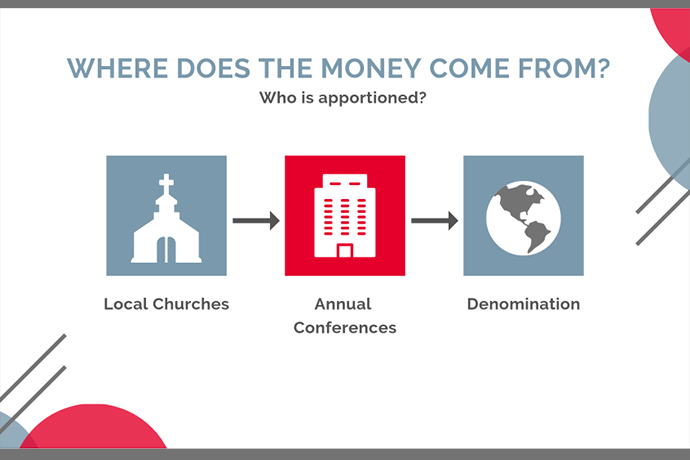
GCFA proposes record-low budget for 2025-2028

United Methodist general agencies are developing their spending plans for the year ahead. They do so as the ongoing fallout of the pandemic, high inflation and rising church disaffiliations are affecting finances throughout the denomination. Original image by Steve Buissinne, courtesy of Pixabay.
The United Methodist Church will look and operate very differently going forward.
That was the frequent refrain at a May 17-19 meeting that saw the denomination’s financial leaders shrink an already record-low proposal for the denominational budget in the wake of new projected losses from church disaffiliations and closures. The leaders also heard input on reducing the number of United Methodist bishops.
Yet even while grieving the departures, the leaders also discussed The United Methodist Church’s opportunities to revitalize and share God’s love with renewed vigor.
“Thinking about mission and ministry while trying to ensure stewardship for years to come is a delicate balance,” said the Rev. Moses Kumar, top executive of the denomination’s General Council on Finance and Administration.
“All of us have dedicated hours to this because each one of us cares deeply about The United Methodist Church.”
He was addressing a gathering that brought together the boards of both the finance agency and the Connectional Table, a leadership body that coordinates denominational ministries and resources.
The GCFA board now is proposing a 2025-2028 denominational budget of about $370.5 million to next year’s General Conference, the denomination’s top policymaking assembly. That’s about $3 million less than the budget the finance agency began working on last fall.
The new bottom line also marks a nearly 40% reduction from the denomination-wide budget that General Conference approved at its last regular meeting in 2016.
The proposal requires significant cuts to all funds that support denomination-wide ministries — including United Methodist general agencies and bishops.
It also will be the lowest budget to come before General Conference since 1984, when the international denomination had far fewer members on the African continent and had yet to establish Africa University, now supported with denominational funds.
Figuring out how to manage such steep reductions and maintain vital ministry around the globe has been a source of tension between the GCFA and Connectional Table directors.
However, after months of negotiations, the two groups on May 18 each unanimously approved recommendations on how to divvy up a much-smaller budget.
“We’ve had some disagreements with GCFA, and we’re happy to end in a spirit of agreement on these numbers,” said Dave Nuckols, the Connectional Table’s treasurer, in presenting the leadership body’s recommended budget allocations.
However, he added that he hoped conversations could continue to restore the collaborative budget process the two boards had previously used in developing the budget recommendations that go before General Conference.
Both the GCFA board and Connectional Table have long agreed the denomination-wide budget should be significantly reduced. But they differed on how low to go while still sustaining ministries at all levels of the denomination.
In The United Methodist Church, local churches provide a share of church giving — called apportionments — to annual conferences, church regional bodies that in turn pay apportionments to general-church ministries.
The U.S. provides the bulk of funding for denomination-wide ministries. In the U.S., the formula for determining an annual conference’s apportionments is its total local church net expenditures multiplied by a General Conference-approved base percentage.
The GCFA board and Connectional Table were at odds about how much to decrease the base percentage proposed to General Conference. The GCFA board initially supported reducing it by 25% in November, while the Connectional Table supported an 18% base-percentage reduction.
Ultimately, the GCFA board decided to reduce the base rate by 22.9%.
The continued drop in the budget proposal — even with a slightly higher base percentage — is the result of the net-expenditure side of the ledger. Net expenditures are what a church spends after capital expenses, apportionments and benevolent giving.
Basically, they are an indicator of the denomination’s financial base. In 2021, U.S. annual conferences saw an overall 7% reduction in church net expenditures due in part to church disaffiliations but especially from church closures amid the COVID-19 pandemic. With that drop in mind, the finance agency has adjusted its projections on net expenditures downward.
This year is likely to see the peak of church disaffiliations under a church law that allows congregations to leave with property if they meet certain conditions. That law is set to expire at the end of 2023.
So far, annual conferences have approved 3,838 disaffiliations — representing a loss of about 12.5% of U.S. congregations since the church law took effect in 2019. Put another way: The majority of U.S. United Methodist churches appear to be remaining in the fold.

A graphic depicts how giving flows from local churches to annual conferences to the denomination-wide ministries of the global United Methodist Church. In a time of mounting church disaffiliations, the denomination’s financial leaders are trying to develop a church-wide budget that keeps in mind needs at all levels of the denomination. Graphic courtesy of the Connectional Table.
It is also unclear how much membership loss these departures will represent since a number of members of exiting congregations are opting to remain United Methodist by transferring to other churches or planting new United Methodist faith communities.
Still, the denomination’s bishops, agency staff and other church leaders are already adjusting to a new reality. Since before the pandemic, the denomination’s general agencies have been budgeting each year with lower giving in mind.
Bishops, too, are trying to shore up the long-shaky Episcopal Fund, the apportionment-supported fund that enables their work.
During their meeting in Nashville, both the Connectional Table and GCFA boards heard from Council of Bishops President Thomas J. Bickerton, who urged the leaders to include the bishops in discussions about reducing their numbers.
He said he is already in conversation with other denominational leaders about the number of bishops needed.
“I don’t think that there’s anyone who is wanting to preserve the episcopacy in its current form,” he said. “The numbers speak for themselves.”
The proposed 2025-2028 budget allocates $68.82 million to the Episcopal Fund. That’s a 25.2% reduction from the budget General Conference approved in 2016.
At present, The United Methodist Church has 59 active bishops — 39 in the U.S.; 13 in Africa; four in Europe and three in the Philippines. That’s seven fewer U.S. bishops than the previous General Conference-approved budget.
However, Rick King, GCFA’s chief financial officer, warned the leaders that under this budget, the Episcopal Fund will be at risk of running out of money if The United Methodist Church returns to a full roster of bishops.
Bickerton said he and his episcopal colleagues recognize this challenge.
He noted that five U.S. bishops face mandatory retirement in 2024, with another two or three who also may retire.
He said leaders of jurisdictions, which elect U.S. bishops, already are considering how to address future elections. In 2028, he added, 16 U.S. bishops face mandatory retirement.
Between 2024 and 2028, he said, denominational leaders will need to think strategically about where bishops can best serve and are most needed. Simply removing bishops from U.S. areas with high numbers of disaffiliations may be counterproductive in reaching the new mission field, he said.
Meanwhile, the entire Eurasia Episcopal Area has embarked on the multi-step process to leave The United Methodist Church, and there are no plans to elect another bishop in that region.
At the same time, church leaders have long been at work on a plan to add five bishops to Africa. Bickerton said his African colleagues are realistic about the financial challenges the denomination now faces.
“My prayer is that we can find a way to collaborate and strategize together to get to the same goal that we all desire,” Bickerton said. “And that’s to position the church to make disciples and make an impact in the world.”
Bishop Mande Muyombo, the Connectional Table’s chair, echoed Bickerton’s sentiments.
In a reflection that opened the meeting on May 18, he acknowledged that church finances are not just about numbers but about lives being transformed.
“That’s the power of The United Methodist Church, a church that has given some of us hope, taken us from a place of scarcity and hopelessness to a place of experiencing God’s love and grace,” prayed Muyombo, who leads the North Katanga Area, which encompasses parts of Congo and Tanzania.
“Lord, I know I speak on behalf of many — not only on my continent of Africa but in the world.”
*Hahn is assistant news editor for UM News. Contact her at (615) 742-5470 or newsdesk@umcom.org.